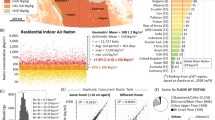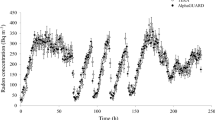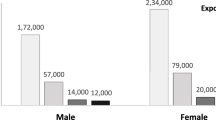Abstract
Excessive exposure to solar UV light is the main cause of skin cancers in humans. UV exposure depends on environmental as well as individual factors related to activity. Although outdoor occupational activities contribute significantly to the individual dose received, data on effective exposure are scarce and limited to a few occupations. A study was undertaken in order to assess effective short-term exposure among building workers and characterize the influence of individual and local factors on exposure. The effective exposure of construction workers in a mountainous area in the southern part of Switzerland was investigated through short-term dosimetry (97 dosimeters). Three altitudes, of about 500, 1500 and 2500 m were considered. Individual measurements over 20 working periods were performed using Spore film dosimeters on five body locations. The postural activity of workers was concomitantly recorded and static UV measurements were also performed. Effective exposure among building workers was high and exceeded occupational recommendations, for all individuals for at least one body location. The mean daily UV dose in plain was 11.9 SED (0.0–31.3 SED), in middle mountain 21.4 SED (6.6–46.8 SED) and in high mountain 28.6 SED (0.0–91.1 SED). Measured doses between workers and anatomical locations exhibited a high variability, stressing the role of local exposure conditions and individual factors. Short-term effective exposure ranged between 0 and 200% of ambient irradiation, indicating the occurrence of intense, subacute exposures. A predictive irradiation model was developed to investigate the role of individual factors. Posture and orientation were found to account for at least 38% of the total variance of relative individual exposure, and were also found to account more than altitude on the total variance of effective daily exposures. Targeted sensitization actions through professional information channels and specific prevention messages are recommended. Altitude outdoor workers should also benefit from preventive medical examination.
This is a preview of subscription content, access via your institution
Access options
Subscribe to this journal
Receive 6 print issues and online access
$259.00 per year
only $43.17 per issue
Buy this article
- Purchase on Springer Link
- Instant access to full article PDF
Prices may be subject to local taxes which are calculated during checkout






Similar content being viewed by others
References
Armstrong B.K., and Kricker A. The epidemiology of UV induced skin cancer. J Photochem Photobiol B 2001: 63 (1-3): 8–18.
Arthey S., and Clarke V.A. Suntanning and sun protection: a review of the psychological literature. Soc Sci Med 1995: 40 (2): 265–274.
Autier P., Doré J.-F., Reis A.C., Grivegnée A., Ollivaud L., and Truchetet F. Sunscreen use and intentional exposure to ultraviolet A and B radiation: a double blind randomized trial using personal dosimeters. Br J Cancer 2000: 83: 1243–1248.
Beral V., and Robinson N. The relationship of malignant melanoma, basal and squamous skin cancers to indoor and outdoor work. Br J Cancer 1981: 44 (6): 886–891.
Berwick M., Armstrong B.K., and Ben-Porat L., et al. Sun exposure and mortality from melanoma. J Natl Cancer Inst 2005: 97 (3): 195–199.
Blumthaler M., Webb A.R., Seckmeyer G., Bais A.F., Huber M., and Mayer B. Simultaneous spectroradiometry: a study of solar UV irradiance at two altitudes. Geophys Res Lett 1994: 21 (25): 2805–2808.
Bouchardy C., Schüler G., and Minder C., et al. Cancer risk by occupation and socioeconomic group among men — a study by The Association of Swiss Cancer Registries. Scand J Work Environ Health 2002: 28 (Suppl1): 1–88.
Boyle P., Maisonneuve P., and Doré J.-F. Epidemiology of malignant melanoma. Br Med Bull 1995: 51: 523–554.
Bulliard J.-L., Cox B., and Elwood J.M. Latitude gradients in melanoma incidence and mortality in the non-Maori population of New Zealand. Cancer Causes Control 1994: 5: 234–240.
Bulliard J.-L., Cox B., and Elwood J.M. Comparison of the site distribution of melanoma in New Zealand and Canada. Int J Cancer 1997: 72: 231–235.
Bulliard J.-L., Panizzon R.G., and Levi F. Prévention du mélanome en Suisse: où en sommes nous ? Rev Med Suisse 2006: 2): 1122–1125.
Bulliard J.-L., and Reeder A. Getting the message across: sun protection information in media weather reports in New Zealand. NZ Med J 2001: 114: 67–70.
Cesarini J.P. Ultraviolet Radiation: Biological effects and health consequences. Third International Non-Ionizing Radiation Workshop; 1996 pp. 55–76.
de Vries E., Bray F.I., Coebergh J.W., and Parkin D.M. Changing epidemiology of malignant cutaneous melanoma in Europe 1953–1997: rising trends in incidence and mortality but recent stabilizations in western Europe and decreases in Scandinavia. Int J Cancer 2003: 107: 119–126.
de Vries E., and Parkin M. Cutaneous malignant melanoma in Europe. [4]. 2003 Cancer Fact Sheets. European Network of Cancer Registries.
Diffey B.L. Solar ultraviolet radiation effects on biological systems. Rev Phys Med Biol 1991: 36 (3): 299–328.
Diffey B.L. Ultraviolet radiation and human health. Clin Dermatol 1998: 16: 83–89.
Egan K.M., Sosman J.A., and Blot W.J. Sunlight and reduced risk of cancer: is the real story vitamin D? J Natl Cancer Inst 2005: 97 (3): 161–163.
Elwood J.M., and Jopson J. Melanoma and sun exposure: an overview of published studies. Int J Cancer 1997: 73: 198–203.
Ferlay J., Bray F., and Pisani P. GLOBOCAN 2000: Cancer Incidence, Mortality and Prevalence Worldwide. IARC Press, Lyon, 2001.
Franceschi S., Levi F., Randimbison L., and La Vecchia C. Site distribution of different types of skin cancer: new aetiological clues. Int J Cancer 1996: 66: 1–5.
Furusawa Y., Quintern L.E., Holtschmidt H., Koepke P., and Saito M. Determination of erythema-effective solar radiation in Japan and Germany with a spore monolayer film optimised for the detection of UVB and UVA — results of a field campaign. Appl Microbiol Biotechnol 1998: 50: 597–603.
Gandini S., Sera F., and Cattaruzza M.S., et al. Meta-analysis of risk factors for cutaneous melanoma: II. Sun exposure. Eur J Cancer 2005a: 41 (1): 45–60.
Gandini S., Sera F., and Cattaruzza M.S., et al. Meta-analysis of risk factors for cutaneous melanoma: III. Family history, actinic damage and phenotypic factors. Eur J Cancer 2005b: 41 (14): 2040–2059.
Geller A.C., Hufford D., and Miller D.R., et al. Evaluation of the ultraviolet index: media reactions and public response. J Am Acad Dermatol 1997: 37 (6): 935–941.
Gies P., Roy C., Toomey S., MacLennan R., and Watson M. Solar UVR exposures of primary school children at three locations in Queensland. Photochem Photobiol 1998: 68 (1): 78–83.
Gies P., and Wright J. Measured solar ultraviolet radiation exposures of outdoor workers in Queensland in the building and construction industry. Photochem Photobiol 2003: 78 (4): 342–348.
Glanz K., and Mayer J.A. Reducing ultraviolet radiation exposure to prevent skin cancer. Am J Prev Med 2005: 29 (2): 131–142.
Hannuksela-Svahn A., Pukkala E., and Karvonen J. Basal cell skin carcinoma and other nonmelanoma skin cancers in Finland from 1956 through 1995. Arch Dermatol 1999: 135: 781–786.
Hill D., White V., Marks R., and Borland R. Changes in sun-related attitudes and behaviours, and reduced sunburn prevalence in a population at high risk of melanoma. Eur J Cancer Prev 1993: 2: 447–456.
Hill D., White V., Marks R., Theobald T., Borland R., and Roy C. Melanoma prevention: Behavioral and nonbehavioral factors in sunburn among an Australian urban population. Prevent Med 1992: 21 (5): 654–669.
IARC Monographs. Evalutation of Carcinogenic Risks to Humans. World Health Organization ed, London, 1992.
International Commission on Illumination. Standard Erythema Dose, A Review. Vienna, Austria, 1997 Report No.: 125.
Jemal A., Devesa S.S., Fears T.R., and Hartge P. Cancer surveillance series: changing patterns of cutaneous malignant melanoma mortality rates among whites in the United States. J Natl Cancer Inst 2000: 92: 811–818.
Kimlin M.G., and Parisi A.V. Usage of real-time ultraviolet radiation data to modify the daily erythemal exposure of primary schoolchildren. Photodermatol Photoimmunol Photomed 2001: 17: 130–135.
Kricker A., Armstrong B.K., and English D.R. Does intermittent sun exposure cause basal cell carcinoma? a case-control study in Western Australia. Int J Cancer 1995: 60 (4): 489–494.
Lee J.A.H., and Scotto J. Melanoma: linked temporal and latitude changes in the United States. Cancer Causes Control 1993: 4: 413–418.
Levi F., Erler G., Te V.C., Randimbison L., and La Vecchia C. Trends in skin cancer incidence in Neuchâtel, 1976–98. Tumori 2001a: 87: 288–289.
Levi F., La Vecchia C., Randimbison L., and Te V.-C. Descriptive epidemiology of soft tissue sarcomas in Vaud, Switzerland. Eur J Cancer 1999: 35 (12): 1711–1716.
Levi F., Lucchini F., and La Vecchia C. Trends in cancer mortality in Switzerland, 1980-2001. Eur J Cancer Prev 2006: 15: 1–9.
Levi F., Te V.C., Randimbison L., Erler G., and La Vecchia C. Trends in skin cancer incidence in Vaud: an update, 1976–1998. Eur J Cancer Prev 2001b: 10: 371–373.
Lim H.S., Roychoudhuri R., Peto J., Schwartz G., Baade P., and Moller H. Cancer survival is dependent on season of diagnosis and sunlight exposure. Int J Cancer 2006: 119: 1530–1536.
McCarthy C.A., and Taylor H.R. A review of the epidemiologic evidence linking ultraviolet radiation and cataracts. Dev Ophtalmol 2002: 35: 21–31.
Moehrle M., Dennenmoser B., and Garbe C. Continuous long-term monitoring of UV radiation in professional mountain guides reveals extremely high exposure. Int J Cancer 2003: 103: 775–778.
Moehrle M., Korn M., and Garbe C. Bacillus subtilis spore film dosimeters in personal dosimetry for occupational solar ultraviolet exposure. Int Arch Occup Environ Health 2000: 73: 575–580.
Mukhtar H., and Elmets C.A. Photocarcinogenesis: mechanisms, models and human health implications. Photochem Photobiol 1996: 63: 356–357.
Parisi A.V., Kimlin M.G., Lester R., and Turnbull D. Lower body anatomical distribution of solar ultraviolet radiation on the human form in standing and sitting postures. J Photochem Photobiol B 2003: 69 (1): 1–6.
Parisi A.V., Kimlin M.G., Wong J.C., and Fleming R.A. The effects of body size and orientation on ultraviolet radiation exposure. Photodermatol Photoimmunol Photomed 1996: 12: 66–72.
Parisi A.V., Meldrum L.R., Kimlin M.G., Wong J.C.F., Aitken J., and Mainstone J.S. Evaluation of differences in ultraviolet exposure during weekend and weekday activities. Phys Med Biol 2000: 45: 2253–2262.
Parkin D.M., Whelan S.L., Ferlay J., Teppo L., and Thomas D.B. Cancer Incidence in Five Continents. IARC Scientific Publications: No. 155, IARC, Lyon, 2002.
Robsahm T.E., Tretli S., Dahlback A., and Moan J. Vitamin D3 from sunlight may imporve the prognosis of breast-, colon- and prostate cancer (Norway). Cancer Causes Control 2004: 15 (2): 149–158.
Salas R., Mayer J.A., and Hoerster K.D. Sun-protective behaviors of California farmworkers. J Occup Environ Med 2005: 47: 1244–1249.
Scotto J., and Fears T.R. The association of solar ultraviolet and skin melanoma incidence among caucasians in the United States. Cancer Invest 1987: 5: 275–283.
Stanton W.R., Janda M., Baade P.D., and Anderson P. Primary prevention of skin cancer: a review of sun protection in Australia and internationally. Health Promot Int 2004: 19 (3): 369–378.
Stepanski B.M., Barbara M., and Mayer J.A. Solar protection behaviors among outdoor workers. J Occup Environ Med 1998: 40 (1): 43–48.
Swerdlow A.J. Incidence of malignant melanoma of the skin in England and Wales and its relationship to sunshine. Brit Med J 1979: 2: 1324–1327.
Woolley T., Buettner P.G., and Lowe J. Sun-related behaviors of outdoor working men with a history of non-melanoma skin cancer. J Occup Environ Med 2002: 44 (9): 847–854.
Wright C., Diab R., and Martincigh B. Anatomical distribution of ultraviolet solar radiation. South Afr J Sci 2004: 100 (9–10): 498–500.
Acknowledgements
We are indebted to the companies Epiney SA (Sierre, Switzerland) and Tapparel Alexis (Montana, Switzerland) who allowed us to perform exposure measurement on their worksites.
The authors acknowledge Dr. Laurent Vuilleumier (MeteoSwiss) for providing data and expertise in the field of ambient irradiation.
This work was supported by a grant from the worker and work relations protection office (SPT) of Valais.
Author information
Authors and Affiliations
Corresponding author
Rights and permissions
About this article
Cite this article
Milon, A., Sottas, PE., Bulliard, JL. et al. Effective exposure to solar UV in building workers: influence of local and individual factors. J Expo Sci Environ Epidemiol 17, 58–68 (2007). https://doi.org/10.1038/sj.jes.7500521
Received:
Accepted:
Published:
Issue Date:
DOI: https://doi.org/10.1038/sj.jes.7500521
Keywords
This article is cited by
-
Evaluation of bactericidal effects of ultraviolet light C irradiation on cariogenic bacteria: An in vitro study
BMC Oral Health (2021)
-
Sun exposure to the eyes: predicted UV protection effectiveness of various sunglasses
Journal of Exposure Science & Environmental Epidemiology (2019)
-
Skin cancer risk perception and sun protection behavior at work, at leisure, and on sun holidays: a survey for Danish outdoor and indoor workers
Environmental Health and Preventive Medicine (2018)
-
A general model to predict individual exposure to solar UV by using ambient irradiance data
Journal of Exposure Science & Environmental Epidemiology (2015)
-
Interventions to decrease skin cancer risk in outdoor workers: update to a 2007 systematic review
BMC Research Notes (2014)



